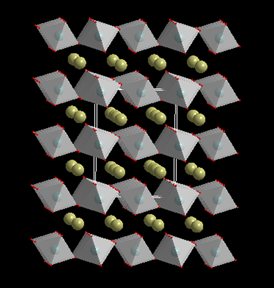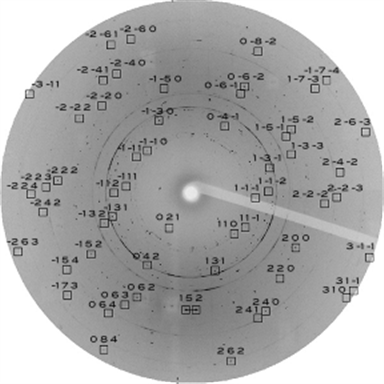Single-crystal structure of (Mg,Fe)SiO3 postperovskite in Earth D" layer - Dr. Li Zhang, Dr. Wenge Yang, Dr. Ho-Kwang Mao
The lowermost several hundred kilometers of the mantle, referred to as D" layer, presents a first-order seismic discontinuity. In 2004, the discovery of postperovskite (denoted ppv) transition in magnesium silicate (MgSiO3), the dominant mineral in Earth mantle, sheds light on the origin of the D" layer. However, experimental determination of the single-crystal structure of ppv was not possible. The conventional single-crystal methods require single crystals with a minimum size of 5-10 microns that are unachievable in phase transition studies at ultrahigh pressures. With a laser-heated diamond anvil cell to simulate conditions in the D", at pressures above 120 gigapascals and temperatures above 2500 kelvin, the researchers first synthesized a polycrystalline ppv sample containing submicron crystallites of ppv. In order to obtain single-crystal structure, they collected the diffraction data by rotating the sample through 51° in 0.2-degree steps, yielding 256 sets of overlapping diffraction patterns (see figure for an example). Then, a computer algorithm sorted through hundreds of submicron crystallites to determine their orientations and to refine the structure of each crystallite. This method allows for single-crystal structure studies under previously inaccessible high pressure conditions with the conventional single-crystal method, opening a new area of high-pressure single-crystal crystallography with expected impact in studies of physics, chemistry, Earth, and Materials sciences.

Figure caption: Crystal structure of (Mg,Fe)SiO3 postperovskite. Polyhedra of O atoms around Si atoms are shown as octahedra, and ~10% Fe2+ ions substitute Mg2+, shown as spheres.
This study reveals that replacing 10% of the magnesium with iron in ppv barely alters its structure. Models of the Earth’s deep interior have been built upon the assumption that the lower mantle mainly consists of iron-bearing magnesium silicate with nominally 10% iron. Excluding the compositional influence on its structure, the results suggest that heterogeneities in seismic data could be attributed to gradients in temperature and pressure and/or changes in bulk composition. Their work is published in the Proceedings of the National Academy of Sciences.

Figure caption: XRD patterns collected in 0.2 steps over the range of 51° were merged into a single image after manually masking out the diamond diffraction spots. Black squares indicate positions of observed peaks from one postperovskite crystallite, and the labels above each square indicate the Miller indices of the peaks.
Link to the paper published on PNAS: http://www.pnas.org/content/early/2013/03/29/1304402110.abstract
Link to report by Physics Today: http://www.physicstoday.org/daily_edition/physics_update/the_crystal_structure_of_a_lower-mantle_mineral
